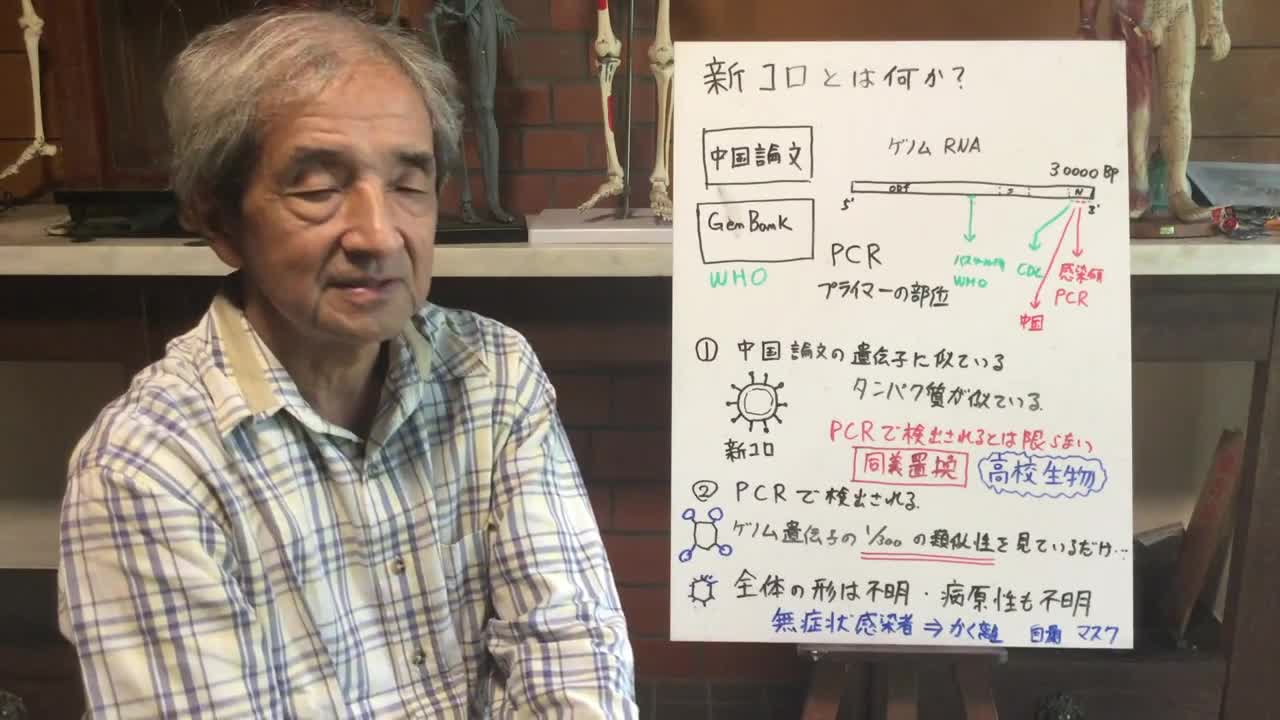Premium Only Content

【123】そもそも新コロウイルスとは何か ここからPCR検査の無意味さが見えてくる - 大橋眞
今回の騒動の原点は、もちろん新コロウイルスです。しかし、新コロウイルスとは、一体何なのかということを説明できる人は少ないと思います。新コロの定義がしっかりと定まっていないと、この問題に対する対処法の検討もできないはずです。検査法、病原性、伝搬性などの検討には、標的をしっかりと絞っておかないと、話がちぐはぐになってしまい、次第に何をしているのかわからなくなってしまう危険性があります。
新コロとは、何かと聞かれると、中国のグループの発表したゲノム遺伝子を持ったウイルスという答えが、模範解答かもしれません。この遺伝子配列に基づいて、PCR検査のシステムが作られました。プライマーという短い遺伝子をウイルスの遺伝子と結合する形に設計して、化学合成します。ゲノム遺伝子は、全長3万塩基もあるので、PCR反応で合成するには長すぎます。そのために、末端に近いところだけを増幅するようにプライマーを設計します。一般的に使われているリアルタイムPCRは、特に短い領域の増幅を得意としています。増幅するのは、プライマーを含めて100塩基ほどの長さです。すなわち全体の300分の1ほどの部分しか、遺伝子を見ていないのです。
新コロの定義を、中国の遺伝子に似ているということにすると、どのくらい似ているとか、基本となる構成単位が似ているとかの範囲を定める必要があります。ウイルスの基本的な機能は、遺伝子が翻訳されたたんぱく質によって、担われています。したがって、遺伝子が似ているというより、翻訳されるたんぱく質が似ているということが重要であり、たんぱく質が同一であれば、ウイルスは同じ機能を持っているということになります。たんぱく質が同一、またはきわめて似ているということが新コロウイルスであるという定義になるのでしょう。しかしもしそうであれば、遺伝子は多くの多形が存在しうるということになります。平均すると1つのアミノ酸あたり3通りのコドン(連続した3つの塩基で構成されたアミノ酸の種類を決めているユニット)が存在します。変異体には、PCRのプライマーが結合しないものも無数に存在する可能性があります。すなわち、PCRで検出できるのは、新コロのごく一部ということになります。
もし、新コロの定義を、PCRで検出できるものとするなら、全体の300分の1の類似性だけを見て、全体が同じと言っているようなものです。これには、何の証拠もありません。全体の形は、調べないとわからないのです。病原性も、わかりません。しかし、現在はPCR陽性ということだけで、無症状者として隔離するとか、PCR陽性者がたくさん出たと言って、自粛や、マスクの生活をすることを求められているのです。このようなPCRで検出できるものを新コロと定義するのは、学問的にもおかしな話です。
本当に存在するのかとか、病原性があるのかというような未解決の問題はたくさんあるものの、中国発表の遺伝子を持ったウイルスと似ているという定義の方が、一貫性はありそうです。しかし、そのように定義するとPCRでは、検出できるとは限らないために、PCR検査は無意味ということになります。
いずれの定義を採用するにしても、PCR検査は医学的に意味がないということになります。中国発表の遺伝子を持ったウイルスと似ているということを定義とするなら、遺伝子の類似性より、たんぱく質レベルでの類似性を調べる抗原検査の方が、理論的には検査の信頼度は高いということになるはずです。
The origin of this uproar is, of course, the new corovirus. However, I don't think there are many people who can explain what the new corovirus is. If the definition of the new roller is not firmly defined, it will not be possible to consider how to deal with this problem. If you don't target your test, pathogenicity, and transmission, you run the risk of getting confused and gradually losing track of what you're doing.
When asked what the new roller is, the answer of a virus with a genomic gene announced by a Chinese group may be a model answer. Based on this gene sequence, a PCR testing system was created. A short gene called a primer is designed to bind to a viral gene and chemically synthesized. Genome genes have a total length of 30,000 bases, which is too long to be synthesized by PCR reaction. Therefore, the primer is designed to amplify only near the end. Real-time PCR, which is commonly used, is particularly good at amplifying short regions. It is amplified to a length of about 100 bases including the primer. In other words, only about 1/300 of the whole is looking at the gene.
If the definition of new roller is similar to the Chinese gene, it is necessary to define the range of how similar it is and how similar the basic constituent units are. The basic function of the virus is carried out by the protein in which the gene is translated. Therefore, it is more important that the translated proteins are similar than the genes are similar, and if the proteins are the same, the virus has the same function. The same or very similar proteins would be the definition of a new corovirus. But if so, the gene can have many polymorphisms. On average, there are three codons per amino acid (a unit that determines the type of amino acid composed of three consecutive bases). There can be a myriad of mutants that do not bind PCR primers. In other words, only a small part of the new roller can be detected by PCR.
If the definition of a new roller can be detected by PCR, it is like saying that the whole is the same by looking at only 1/300 of the similarity. There is no evidence of this. You can't know the whole shape without examining it. I don't know the pathogenicity either. However, at present, just because they are PCR-positive, they are required to refrain from doing so and to live in masks because they are isolated as asymptomatic people or there are many PCR-positive people. It is academically strange to define what can be detected by such PCR as a new roller.
Although there are many unsolved questions such as whether it really exists or is pathogenic, the definition that it resembles a virus with a gene announced in China seems to be more consistent. However, such a definition makes the PCR test meaningless because it is not always detectable by PCR.
Regardless of which definition is adopted, the PCR test is medically meaningless. If we define that it is similar to a virus with a gene published in China, the reliability of the test is theoretically higher for an antigen test that examines similarity at the protein level than for gene similarity. That should be the case.
-
 2:07:22
2:07:22
Inverted World Live
10 hours agoGiant Asteroid Skims Past Earth Today | Ep. 102
47.1K5 -
 3:11:00
3:11:00
TimcastIRL
8 hours agoTrump Kills 11 Narco Terrorists, Democrats Warn War With Venezuela Coming | Timcast IRL
179K199 -
 13:07
13:07
Robbi On The Record
3 days ago $6.27 earnedSweet Poison: The Big Fat Lie That’s Killing America
52.1K26 -
 5:35:49
5:35:49
Drew Hernandez
13 hours agoEPSTEIN VICTIMS SPEAK OUT & TRUMP DOUBLES DOWN
46.9K37 -
 1:36:41
1:36:41
FreshandFit
8 hours agoWe Are QUITTING YouTube...
63.6K52 -
 2:34:22
2:34:22
TheSaltyCracker
8 hours agoDrug Smugglers Blown Up 9-03-25
107K220 -
 3:12:59
3:12:59
VapinGamers
7 hours ago $1.81 earnedGrim Trials - Game Review/Playthru - Rougelight Dungeon Crawler - !rumbot !music
34.4K -
 2:47:55
2:47:55
Mally_Mouse
15 hours ago🎮 Let's Play!! -- Jak 2 pt. 16
64.7K2 -
 52:23
52:23
MattMorseTV
9 hours ago $19.80 earned🔴The Cartels are SCREWED.🔴
125K135 -
 1:32:46
1:32:46
Badlands Media
23 hours agoAltered State S3 Ep. 44: Epstein Files, Corrupt Judges, and the College Grift
61.9K3